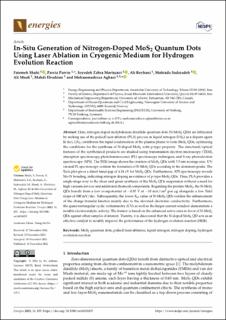| dc.contributor.author | Shahi, Fatemeh | |
| dc.contributor.author | Parvin, Parviz | |
| dc.contributor.author | Mortazavi, Seyedeh Zahra | |
| dc.contributor.author | Reyhani, Ali | |
| dc.contributor.author | Sadrzadeh, Mohtada | |
| dc.contributor.author | Moafi, Ali | |
| dc.contributor.author | Ebrahimi, Mahdi | |
| dc.contributor.author | Aghaei, Mohammadreza | |
| dc.date.accessioned | 2023-05-25T07:36:30Z | |
| dc.date.available | 2023-05-25T07:36:30Z | |
| dc.date.created | 2023-03-20T12:25:03Z | |
| dc.date.issued | 2022 | |
| dc.identifier.citation | Energies. 2022, 16 (1), . | en_US |
| dc.identifier.issn | 1996-1073 | |
| dc.identifier.uri | https://hdl.handle.net/11250/3068930 | |
| dc.description.abstract | Here, nitrogen doped molybdenum disulfide quantum dots (N-MoS2 QDs) are fabricated by making use of the pulsed laser ablation (PLA) process in liquid nitrogen (LN2) as a dopant agent. In fact, LN2 contributes the rapid condensation of the plasma plume to form MoS2 QDs, optimizing the conditions for the synthesis of N-doped MoS2 with p-type property. The structural/optical features of the synthesized products are studied using transmission electron microscopy (TEM), absorption spectroscopy, photoluminescence (PL) spectroscopy techniques, and X-ray photoelectron spectroscopy (XPS). The TEM image shows the creation of MoS2 QDs with 5.5 nm average size. UV-vis and PL spectroscopy confirm the formation of N-MoS2 QDs according to the dominant peaks. The Tuck plot gives a direct band-gap of 4.34 eV for MoS2 QDs. Furthermore, XPS spectroscopy reveals Mo-N bonding, indicating nitrogen doping as evidence of p-type MoS2 QDs. Thus, PLA provides a single-stage way to the clean and green synthesis of the MoS2 QDs suspension without a need for high vacuum devices and additional chemical components. Regarding the pristine MoS2, the N-MoS2 QDs benefit from a low overpotential of −0.35 V at −10 mA/cm2 per µg alongside a low Tafel slope of 300 mV/dec. Subsequently, the lower Rct value of N-MoS2 QDs verifies the enhancement of the charge transfer kinetics mainly due to the elevated electronic conductivity. Furthermore, the quasi-rectangular cyclic voltammetry (CV) as well as the larger current window demonstrate a notable electrocatalytic activity. The former is based on the enhanced active sites in favor of N-MoS2 QDs against other samples of interest. Thereby, it is discovered that the N-doped MoS2 QD acts as an effective catalyst to notably improve the performance of the hydrogen evolution reaction (HER). | en_US |
| dc.language.iso | eng | en_US |
| dc.publisher | MDPI | en_US |
| dc.rights | Attribution-NonCommercial-NoDerivatives 4.0 Internasjonal | * |
| dc.rights.uri | http://creativecommons.org/licenses/by-nc-nd/4.0/deed.no | * |
| dc.title | In-Situ Generation of Nitrogen-Doped MoS2 Quantum Dots Using Laser Ablation in Cryogenic Medium for Hydrogen Evolution Reaction | en_US |
| dc.title.alternative | In-Situ Generation of Nitrogen-Doped MoS<inf>2</inf> Quantum Dots Using Laser Ablation in Cryogenic Medium for Hydrogen Evolution Reaction | en_US |
| dc.type | Peer reviewed | en_US |
| dc.type | Journal article | en_US |
| dc.description.version | publishedVersion | en_US |
| dc.source.pagenumber | 15 | en_US |
| dc.source.volume | 16 | en_US |
| dc.source.journal | Energies | en_US |
| dc.source.issue | 1 | en_US |
| dc.identifier.doi | 10.3390/en16010455 | |
| dc.identifier.cristin | 2135289 | |
| cristin.ispublished | true | |
| cristin.fulltext | original | |
| cristin.qualitycode | 1 | |

